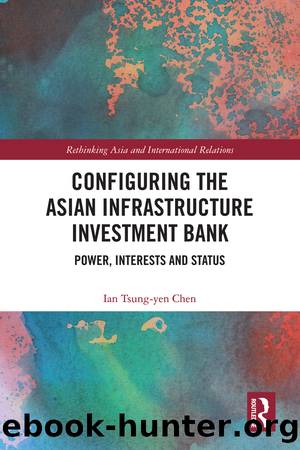Configuring the Asian Infrastructure Investment Bank: Power, Interests and Status by Ian Tsung-Yen Chen

Author:Ian Tsung-Yen Chen [Chen, Ian Tsung-Yen]
Language: eng
Format: epub
Tags: International Relations, Trade & Tariffs, Banks & Banking, Finance, Political Science, World, Business & Economics, Asian, General
ISBN: 9780429789519
Google: cd8JEAAAQBAJ
Goodreads: 54209553
Publisher: Routledge
Published: 2020-12-29T00:00:00+00:00
India: participation and restraint
India is an emerging global power hungry for inward investment in its infrastructure. Although the level of Indiaâs physical and social infrastructure tops that of other South Asian developing countries, it still lags behind its fellow BRICS (Brazil, Russia, India, China, South Africa). Where it is most lacking is in access to electric power, internet access, level of air travel and quality of seaports. The elimination of poverty and access to health care, education and vocational training are also pressing items on the national agenda (Agrawal, 2015). According to the Global Competitiveness Report, Indiaâs overall infrastructure performance ranked 68th out the 138 countries or economies surveyed (Schwab, 2016). Although its transportation facilities, especially rail, outperform many developing economies, it only ranks 88th in terms of electric power supply, putting it in the 36th percentile. The situation is even worse in rural areas. Instead of the construction or upgrading of basic transportation networks, efficient, reliable and affordable electricity supplies are critical to the countryâs economic growth (Allcott, Collard-Wexler, & OâConnell, 2016). To sustain economic momentum, India is seeking to build closer connections with both the East and the West. Improving air, land and sea connectivity to the East is expected to generate trade and investment opportunities. Integration with countries to the west will open up more business opportunities and ensure a supply of oil from the Middle East across the Arabian Sea for this energy-hungry country. In 2018, Indiaâs top four oil suppliers were in the Middle East (Abdi, 2018). The structure of Indiaâs external trade relations demonstrates the importance of improving regional connectivity. According to official data, most of Indiaâs top trading partners are in East Asia or the Middle East.3 Improving linkages with these regional countries is Indiaâs main challenge.
This major regional and global power had the worldâs second largest population (1.31 billion) and was its seventh largest economy in 2018.4 Since 1990, China and India have been considered to be the two most promising emerging powers in Asia. They were numbered among the BRICS by Goldman Sachs for their outstanding economic growth (OâNeill, 2011). At the beginning of the 1990s, Indiaâs GDP rivaled Chinaâs GDP, both of which were around US$350 billion (in current US$). Due to its smaller population, India had a higher GDP per capita in the early 1990s. Since the mid-1990s, however, Chinaâs GDP has rapidly surpassed that of India, making it the worldâs second largest economy, producing five times more than India both in total and per capita. In terms of military spending, India spent a little more than China, although both countries spent about US$10 billion. Since then, the gap has widened rapidly. In 2018, China spent US$250 billion on its military, 3.76 times more than India.5 If one accepts that a stateâs national power includes both economic scale and military power, the power gap between China and India has widened between the 1990s and the 2010s. Faced with Chinaâs ever-increasing dominance in the region and Beijingâs geopolitical and geo-economic expansion, some Indian scholars took the attitude that âif you canât beat them, join them.
Download
This site does not store any files on its server. We only index and link to content provided by other sites. Please contact the content providers to delete copyright contents if any and email us, we'll remove relevant links or contents immediately.
Spell It Out by David Crystal(35852)
Life for Me Ain't Been No Crystal Stair by Susan Sheehan(35539)
Cecilia; Or, Memoirs of an Heiress — Volume 1 by Fanny Burney(32068)
Cecilia; Or, Memoirs of an Heiress — Volume 3 by Fanny Burney(31463)
Cecilia; Or, Memoirs of an Heiress — Volume 2 by Fanny Burney(31413)
The Great Music City by Andrea Baker(30794)
Professional Troublemaker by Luvvie Ajayi Jones(29425)
We're Going to Need More Wine by Gabrielle Union(18641)
Twilight of the Idols With the Antichrist and Ecce Homo by Friedrich Nietzsche(18305)
The Secret History by Donna Tartt(18196)
Cat's cradle by Kurt Vonnegut(14773)
All the Missing Girls by Megan Miranda(14772)
Pimp by Iceberg Slim(13790)
Bombshells: Glamour Girls of a Lifetime by Sullivan Steve(13692)
Fifty Shades Freed by E L James(12923)
Talking to Strangers by Malcolm Gladwell(12888)
Norse Mythology by Gaiman Neil(12848)
The Social Justice Warrior Handbook by Lisa De Pasquale(11957)
Underground: A Human History of the Worlds Beneath Our Feet by Will Hunt(11844)
